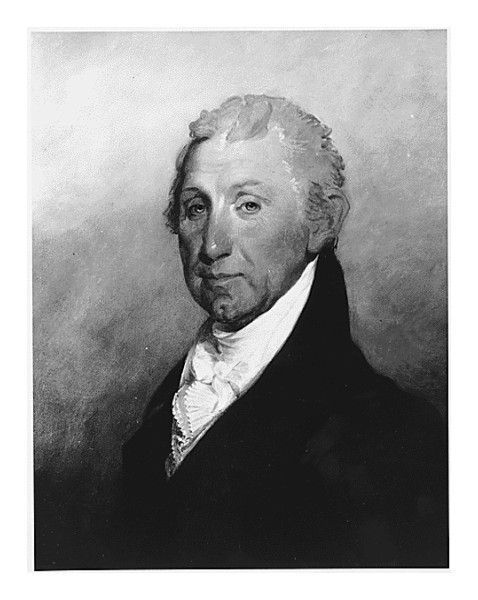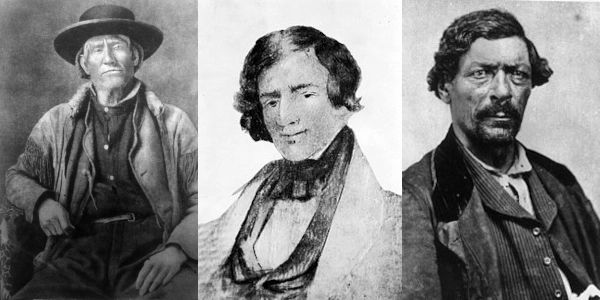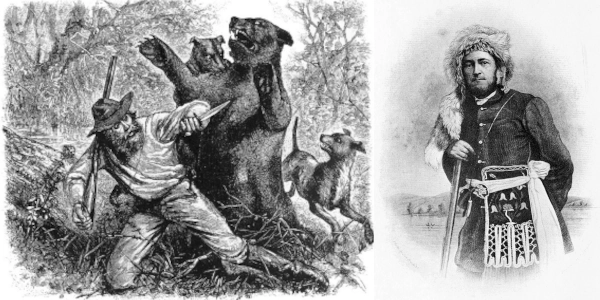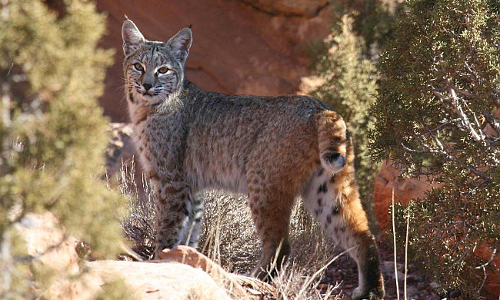
Image above: President James Monroe. Image right: Triumph, depicting eventual victory of Union, with reference to the Missouri Compromise. Created by Morris H. Traubel, 1861. Images courtesy Library of Congress.
Sponsor this page for $75 per year. Your banner or text ad can fill the space above.
Click here to Sponsor the page and how to reserve your ad.
-
Timeline
1822 Detail
February 13, 1822 - Advertisements for Ashley's Hundred, organized by General William H. Ashley and Major Andrew Henry, to ascend the Missouri River on a fur trading mission, appear in Missouri newspapers. The men who would answer the call to employ included Jedediah Smith and Jim Bridger. Over the next decade, these expeditions would leave St. Louis at irregular intervals.

General William Henry Ashley had moved west from Virginia in 1803, settling in St. Louis by 1808. He made his first fortune there from finding a saltpeter cave near the Current River and manufacturing gunpowder from it. How did he become a general? When the War of 1812 began, Ashley joined the Missouri Militia and rose to that rank. He began to dabble in politics as well, and in 1820, became the State of Missouri's 1st Lieutenant Governor.
While Ashley also had his foot in Missouri politics, Andrew Henry was his business partner, making bullets to go along with Ashley's gunpowder, and they decided, in 1822, at Potosi, to form the Rocky Mountain Fur Company. At this time, the company had no men, so Ashley placed ads in St. Louis newspapers.
"To enterprising young men, the subscriber wishes to engage ONE HUNDRED MEN to ascend the river Missouri to its source, there to be employed for one, two, or three years - For particulars, enquire of Major Andrew Henry, near the Lead Mine, in the County of Washington, (who will ascend with, and command the party) or to the subscriber in St. Louis. Wm. H. Ashley, February 13, Missouri Republic."
Those men, the one hundred and eighty who showed, would be known as Ashley's Hundred. They included such men as Jim Bridger, Jedediah Smith, Jim Beckwourth, William Sublette, David Jackson, Tom Fitzpatrick, Mink Fink, Milton Sublette, James Clyman, Hugh Glass (of The Revenant movie fame), and more. Ashley knew, however, that he had competition. The Missouri Fur Company, of which Andrew Henry had previously worked for, was trapping some of the traditionally rich area of beaver along the tributaries and Missouri, which were becoming less productive. Ashley knew he would have to explore new areas to find a rich amount of beaver pelts.
The First Trading Trips
For the first three years, Ashley's Hundred made several fur trapping trips for the Rocky Mountain Fur Company. Ashley wanted all of the participants in the fur trade; trappers, Indians, and traders, to meet at an annual location to exchange. Ashley and Henry used a unique payment system for the time; the trappers kept half the proceeds and gave the other half to management.
However, prior to the establishment of the first rendezvous, Ashley sent an expedition into the Bighorn Canyon in 1823 while sending couriers into Wyoming to remind others to meet along the Yellowstone River to trade.
In 1824, the trading expedition met a series of horrible fates and low profits, convincing Andrew Henry to quit the business. This meant that Ashley himself would lead the next expedition in the fall of 1824, a far-reaching trip that took Ashley's Hundred to Colorado, Wyoming, Idaho, and Utah for nine months. In January 1825, Ashley and his men met at the first large scale rendezvous at Henry's Fort along the Green River in Wyoming. It was very profitable. However, Ashley decided that a trip through the waters in Bighorn Canyon would be too dangerous to their haul and decided to take the Bad Pass Trail. One man, Jim Bridger, took the chance, building a boat and became the first man to navigate the Bighorn River through the canyon.
Ashley met the Bighorn River below the canyon at Grapevine Creek at the end of the Bad Pass Trail, floating the rest of the way on bullboats they constructed. He sent William Sublette back with a company of men to keep trapping while he went forward with the rest to St. Louis, arriving on October 4, 1825. At St. Louis, Ashley and the Rocky Mountain Fur Company sold one hundred beaver pelts for $50,000.
The rendezvous system was a success. The men could go out in smaller parties in the summer when the beavers left their streams. Ashley would start to prefer overland routes rather than water in order to safeguard their treasure. The rendezvous would eventually became a weeks long festival that traded pelts and other goods, but also included the revelry of card games, back woods stories, eating, and drinking. The system would last for over one decade.

Ashley Sells the Rocky Mountain Fur Company
It's hard to believe how well the company did over its first four years. Beyond opening up the west to further expansion, General Ashley made a whole lot of money and gained a national reputation. He sold the company in 1826 to Jedediah Smith, William Sublette, and David Jackson. While the Rocky Mountain Fur Company moved on with him, Ashley became a full-time politician, already having been a Lt. Governor, and later, from 1831-1837, gaining the office of U.S. Representative.
In 1830, Jedediah Smith, William Sublette, and David Jackson sold out to Jim Bridger, Milton Sublette, Tom Fitzpatrick and two others. By that time, they were buying a diminishing business. Although the company continued for four more years, the competition with Astor's American Fur Company and the Hudson Bay Company, both of which had more territory, a change in fashion taste from fur to silk hats, and lower beaver, bear, and other animal populations caused their demise. After several skirmishes with their competition, who were underselling the Rocky Mountain Fur Company, and Indian tribes, the men of Ashley's Hundred sold out. Who to? Their hated rival, Astor's American Fur Company.
Image above: Montage (left) Jim Bridger, 1911, unknown author. Courtesy Gaston's Portland, Oregon, Its History and Builders, Volume 1, via Wikipedia Commons. (center) Jedediah Smith, 1835, friend of Smith. Courtesy "The travels of Jedediah Smith, 1934, Maurice Sullivan via Wikipedia Commons. (right) Jim Beckwourth, circa 1856, unknown author. Courtesy "The Life and Times of James P. Beckwourth," 1856, T.D. Bonner, via Courtesy Wikipedia Commons. Image below: Montage (left) Newspaper drawing of Hugh Glass being attacked by a bear, unknown date or author. Courtesy Wikipedia Commons; Joseph Meek, 1870, Joseph Buchtel and John Chester Buttre. Courtesy "The River of the West, Life and Adventure in the Rocky Mountains and Oregon," via Wikipedia Commons. Source Info: Wikipedia Commons; Library of Congress; Legendsofamerica.com; National Park Service; washingtoncomo.com.







